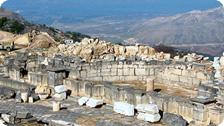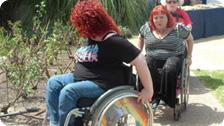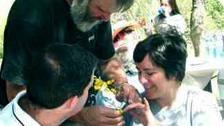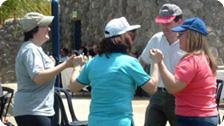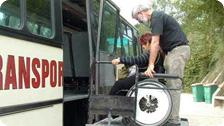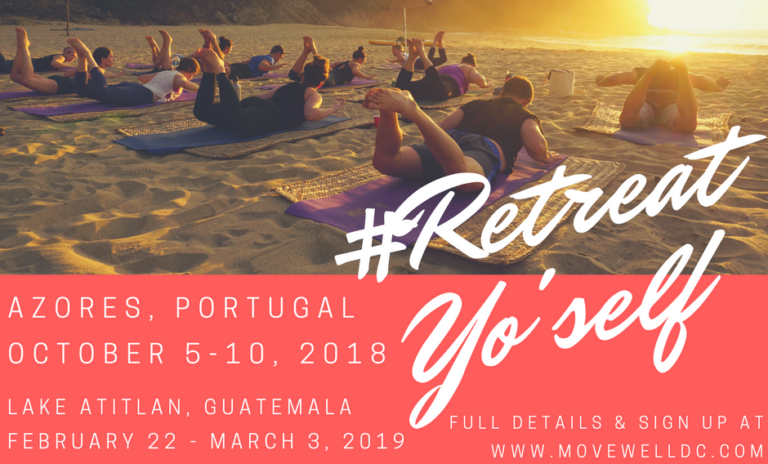Wellness: Israel: Enabling Inspiration, Special Trips for Special Needs
by Janet Bein
A native-born Israeli, Eli is a tall, broad-shouldered man, with a short, graying beard. He lives in the rural village of Benjamina (between Haifa and Tel Aviv), likes to wear jeans, and looks like a cross between a kibbutznik and a rabbi.
For more than fifteen years, Eli has worked in the field of Rehabilitation, helping veterans and terrorist victims as well as other disabled individuals. He coordinated case management and served as executive director in rehabilitation centers for clients with mobility, visual, hearing, and emotional disabilities.
In 1997, Eli branched out from his original profession and opened a special needs department within a tourist agency. When asked why he made this switch, he said, “In the rehabilitation centers, we are dealing with the weaknesses of the individual. I wanted to work with their strengths.”
In order for disabled individuals to find and express their vibrant spirits, he has been an ardent advocate for increased accessibility to public buildings, museums, hotels, transportation, and tourist sites. As a member of the international Society for Accessible Travel and Hospitality (SATH), he created a department for special needs travel within an established tourist agency in Israel.
Eli fervently believes that everyone should experience Israel—regardless of whether the person is visually impaired, hearing-impaired, wheelchair bound or has some other disability.
While Eli operates and provides services for many tour groups comprised primarily of disabled individuals, he also provides services allowing disabled individuals to join their families or other organized tours that are comprised of non-disabled individuals. He also provides support services for a disabled individual traveling alone.
Recently, he arranged an oxygen supply for a woman from the USA who was traveling around Israel. For every place that she stopped overnight, Eli had made preparations to have oxygen ready. The woman was even able to take an extension trip to Petra, thanks to an oxygen supply in Eilat and a special cart that transported her around the wondrous ruins of Petra.
A more challenging case involved a blind woman from Canada, who was having trouble getting a tour operator to accept her and her guide dogs as part of an organized tour. Eli was able to persuade a tour operator to provide the additional services necessary for her and her guide dogs to participate in activities with other members of the group.
An important part of Eli’s work has been persuading the government and private companies to improve accessibility of tourist sites.
Eli takes particular pride in the accessibility features of Masada, a desert fortress, perched on one of the highest peaks in the Negev. On its eastern side, the rock falls in a sheer drop of nearly 1500 feet to the Dead Sea, which is the lowest point on earth, more than 1300 feet below sea level. On the western side, the slope is 328 feet above the surrounding terrain. The natural approaches to the cliff top are very difficult.
But in recent years, this site has been made “wheelchair-friendly.” A wide cable car brings tourists to the top of the site, and a smooth path allows people with walkers or in wheelchairs to tour the ruins of this final stronghold of the Jewish rebels, who fled to Masada after the fall of Jerusalem in 70 CE. When besieged by overwhelming force, nearly one thousand defenders (men, women, and children) committed suicide rather than be taken alive by the Romans.
No visit to Israel could be complete without a visit to this site, which plays such an important role in the modern Israeli psyche that there is a term for it, the “Masada complex.” With relatively new accessibility adaptations, all visitors to Israel can reach and explore the site.
Sometimes, there is no way to make a wheelchair-friendly path without disturbing the historic, architectural integrity of a site. It would be difficult for a wheelchair to navigate the narrow, bumpy cobblestone streets and stairs of the Old Jewish Quarter in Jerusalem. So for physically disabled individuals visiting the kotel (Western Wall), a special van takes them into the plaza.
From my own travel experience, I have found it more interesting to stay in a Bed and Breakfast rather than in a large hotel. The intimacy of a smaller place allows you to talk more to local people and fellow guests. This type of accommodation is also available to individuals in wheelchairs.
There are a number of van accessible villas within the beautiful, rural landscapes of the Golan Heights and the Galilee, as well as in urban Tel Aviv and Jerusalem. Eli can also make arrangements for extension stays at van accessible villas in Crete, Greece, or Cyprus.
Eli can arrange heritage tours for Jewish, Christian, and Muslim tourists or create customized adventure tours. If you have wanted to travel to Israel but felt it was beyond your reach because of some disability, you need wait no longer. Eli has the experience and the resources to help make your dream come true.
For more information about special needs travel, please check out Eli’s website, appropriately named, http://israelaccessibletravel.com
Discover more from Tango Diva
Subscribe to get the latest posts sent to your email.
